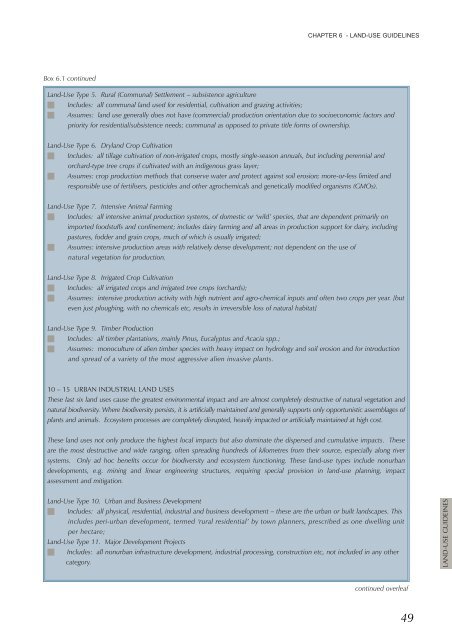Mpumalanga Biodiversity Conservation Plan Handbook - bgis-sanbi
Mpumalanga Biodiversity Conservation Plan Handbook - bgis-sanbi
Mpumalanga Biodiversity Conservation Plan Handbook - bgis-sanbi
Create successful ePaper yourself
Turn your PDF publications into a flip-book with our unique Google optimized e-Paper software.
Box 6.1 continued<br />
Land-Use Type 5. Rural (Communal) Settlement – subsistence agriculture<br />
Includes: all communal land used for residential, cultivation and grazing activities;<br />
CHAPTER 6 - LAND-USE GUIDELINES<br />
Assumes: land use generally does not have (commercial) production orientation due to socioeconomic factors and<br />
priority for residential/subsistence needs; communal as opposed to private title forms of ownership.<br />
Land-Use Type 6. Dryland Crop Cultivation<br />
Includes: all tillage cultivation of non-irrigated crops, mostly single-season annuals, but including perennial and<br />
orchard-type tree crops if cultivated with an indigenous grass layer;<br />
Assumes: crop production methods that conserve water and protect against soil erosion; more-or-less limited and<br />
responsible use of fertilisers, pesticides and other agrochemicals and genetically modified organisms (GMOs).<br />
Land-Use Type 7. Intensive Animal Farming<br />
Includes: all intensive animal production systems, of domestic or ‘wild’ species, that are dependent primarily on<br />
imported foodstuffs and confinement; includes dairy farming and all areas in production support for dairy, including<br />
pastures, fodder and grain crops, much of which is usually irrigated;<br />
Assumes: intensive production areas with relatively dense development; not dependent on the use of<br />
natural vegetation for production.<br />
Land-Use Type 8. Irrigated Crop Cultivation<br />
Includes: all irrigated crops and irrigated tree crops (orchards);<br />
Assumes: intensive production activity with high nutrient and agro-chemical inputs and often two crops per year. [but<br />
even just ploughing, with no chemicals etc, results in irreversible loss of natural habitat]<br />
Land-Use Type 9. Timber Production<br />
Includes: all timber plantations, mainly Pinus, Eucalyptus and Acacia spp.;<br />
Assumes: monoculture of alien timber species with heavy impact on hydrology and soil erosion and for introduction<br />
and spread of a variety of the most aggressive alien invasive plants.<br />
10 – 15 URBAN INDUSTRIAL LAND USES<br />
These last six land uses cause the greatest environmental impact and are almost completely destructive of natural vegetation and<br />
natural biodiversity. Where biodiversity persists, it is artificially maintained and generally supports only opportunistic assemblages of<br />
plants and animals. Ecosystem processes are completely disrupted, heavily impacted or artificially maintained at high cost.<br />
These land uses not only produce the highest local impacts but also dominate the dispersed and cumulative impacts. These<br />
are the most destructive and wide ranging, often spreading hundreds of kilometres from their source, especially along river<br />
systems. Only ad hoc benefits occur for biodiversity and ecosystem functioning. These land-use types include nonurban<br />
developments, e.g. mining and linear engineering structures, requiring special provision in land-use planning, impact<br />
assessment and mitigation.<br />
Land-Use Type 10. Urban and Business Development<br />
Includes: all physical, residential, industrial and business development – these are the urban or built landscapes. This<br />
includes peri-urban development, termed ‘rural residential’ by town planners, prescribed as one dwelling unit<br />
per hectare;<br />
Land-Use Type 11. Major Development Projects<br />
Includes: all nonurban infrastructure development, industrial processing, construction etc, not included in any other<br />
category.<br />
continued overleaf<br />
49<br />
LAND-USE GUIDEINES

















